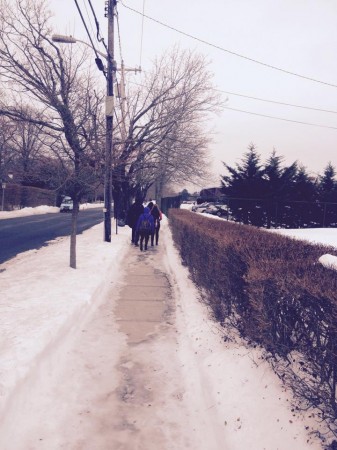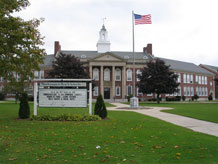Student Unrest: School Sidewalks Not Wide Enough
Westhampton Beach sidewalks are not wide enough, and according to national safety standards, our community’s exceedingly narrow sidewalks restrict traffic, hurt business, and endanger pedestrians. WHBHS sidewalks fit 2 people at most (a hotly debated topic), averaging about three to four feet in width. According to an AARP study, the minimum sidewalk width needed to sustain healthy pedestrian traffic is five to six feet. In Westhampton Beach, narrow sidewalks reduce customer flow to nearby businesses, fracture pedestrian groups, and make walking to and from the school an unpleasant ordeal.
“Sidewalks only fit two people,” begins WHBHS senior Scott Sinnickson, “and that’s where the issue arises.” Sinnickson, who embarks daily on the journey to Boom Burger, right down the street on the corner of Montauk Highway. Sinnickson always walks with a group of friends, and as he puts it, “our group always gets broken up because we only fit on the sidewalk two at a time. Some of us end up staying on the sidewalk, some lag behind, and some have to walk in the street because there isn’t enough room on the ‘walk.” This exemplifies what he calls the Third Man On The Sidewalk theory: in a group of three people, two will end up side-by-side, and the “third man” will inevitably follow behind them.
Walking in the street defeats the purpose of the sidewalk: it is messy and dangerous, and the pedestrian needs to be always alert for oncoming cars. And as if having a few people off the sidewalk weren’t bad enough, there are times when the only option is for everyone to walk in the street.
Ever since the last snowfall, the Lilac sidewalk has been piled high with four-foot snow drifts, rendering the sidewalk inaccessible and forcing high schoolers to walk in the muddy, slushy street. And even though it has since been cleared of snow, basic maintenance problems persist: the snow piles have been replaced with 3-inch ice sheets. The last time Sinnickson and company attempted to walk to Boom Burger across the ice, several members of the group, trying to walk side-by-side with others on the narrow sidewalk, repeatedly slipped and fell, unable to maintain their balance for more than a few feet at a time. With wider and better-maintained sidewalks, the risk of such accidents could be reduced to zero, and the children of America could once again use the sidewalks, unafraid.
But in Sinnickson’s opinion, if the sidewalks were just a few feet wider, it would greatly increase the integrity of his pedestrian group, and the walk to lunch down the street would be pleasant and, most importantly, safe.
There are, as with any social issue, dissenters: the contrarian, stubborn, close-minded ones, who insist that the sidewalks fit three people instead of two, and persist to do so in the face of irrefutable evidence. They lead their own moral crusade against the voice of the masses, validating government errors with weak arguments, inconclusive evidence, and heated debates over the true nature of the issue. WHBHS senior Nick “Warpath” Walrath is one of them. “The sidewalks fit three people,” he declared one chilly winter day, “there’s no three ways about it. The Third Man On The Sidewalk theory is simply wrong.” Walrath leads the opposition group, pushing for it to be called the Fourth Man On The Sidewalk. “Three to tango,” Walrath reminds his fellow pedestrians, “It takes three to tango.”
The SafeRoutes organization is among the many lobbyists for sidewalk expansion. In their community engineering guide, they address the issue of narrow sidewalks: “Sidewalks with a width of eight to ten feet or more should be built along roads adjacent to school grounds where large numbers of walkers are expected” (SRTS Guide- Sidewalks). They say that for people to walk together is integral in advancing social interaction, and that sidewalks are the only tool to help build these interactions: where sidewalks aren’t wide enough, social walking breaks down. AARP also did a study a few years ago, in which the organization assessed the social and economic impact of widened sidewalks. The results they reported were clear: “Eight in 10 Americans prefer being in a community that offers sidewalks and good places to walk” (Livability). According to further findings, adding a 5-foot sidewalk to an average home could increase selling prices by up to $30000.
“Someone really needs to do something about the sidewalk issue,” say, as if in unison, Marisa Valentino and John Tocco, “and that something needs to happen now.”
Sources Used:

Stephan is a senior from Quiogue. This is his first year writing for The Hurricane Eye, and he is excited to be in Journalism. He plans to study pre-med...







